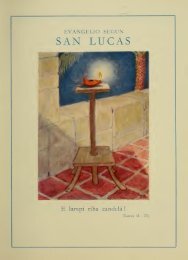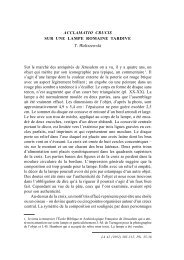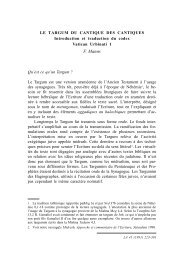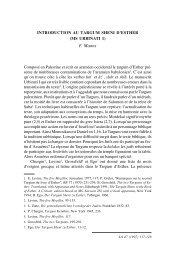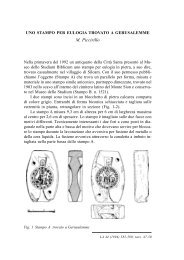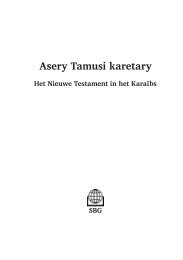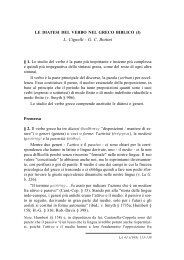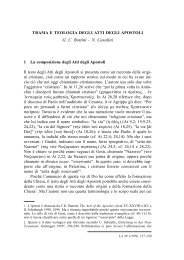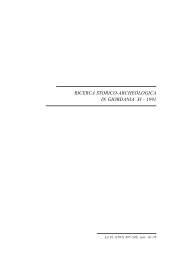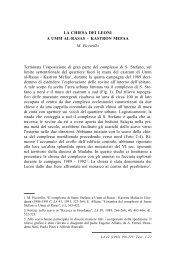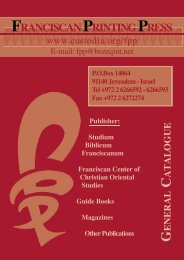Literary Criticism and Theology of P - Christus Rex
Literary Criticism and Theology of P - Christus Rex
Literary Criticism and Theology of P - Christus Rex
Create successful ePaper yourself
Turn your PDF publications into a flip-book with our unique Google optimized e-Paper software.
28<br />
E. CORTESE<br />
been behind them, for a century, a strong polemic between Christian <strong>and</strong> Jewish<br />
scholars about the importance <strong>of</strong> the Law. Jews defending the Law, sometimes<br />
accused the western exegetes <strong>of</strong> anti-Semitism 57 . There is, <strong>of</strong> course, the<br />
danger <strong>of</strong> the older Protestant radicalism in interpreting the OT <strong>and</strong> NT data<br />
about the human corruption <strong>and</strong> the original sin, which usually is not acceptable<br />
to Judaism.<br />
Diverging theses about this question, however, came closer <strong>and</strong> closer in<br />
the last decades. On the one side the Jews became more <strong>and</strong> more conscious<br />
<strong>of</strong> the necessity <strong>of</strong> the grace <strong>of</strong> God, expressed already by the divine election,<br />
which they incline to call “covenant”. On the other side the incapacity <strong>of</strong><br />
fulfilling the law <strong>and</strong> the covenant is seen by the Protestants less radically<br />
than in the past. In spite <strong>of</strong> the fact that some divergences remain among the<br />
Christian Theologians, especially in the interpretation <strong>of</strong> the Paul’s message<br />
on the law <strong>and</strong> grace 58 , we could affirm that there are today better premises<br />
for a more pr<strong>of</strong>itable discussion <strong>and</strong> confrontation.<br />
2. The specific problem: P-H. Coming back to our proper question, we try<br />
now to solve it, by affirming that P <strong>and</strong> H are not to be separated, that the law<br />
at Sinai is not suppressed, <strong>and</strong> that the berît has been simply translated into H.<br />
The importance <strong>of</strong> the law, as set at Sinai already by Pg, is demonstrated<br />
simply by the ‘edût in the ark. P changes only the dtr formula ’arôn berît into<br />
its ’arôn ha‘edût. Later redactions <strong>of</strong> P develop this line adding Lev 1-7, on<br />
the sacrifices, <strong>and</strong> 11-15, the so called Purity Code. The first group <strong>of</strong> Law<br />
comes from the priestly pr<strong>of</strong>essional da‘at, or ceremonial norms, which the<br />
priests have to know in practicing their job. Its insertion at Sinai transforms<br />
such pr<strong>of</strong>essional knowledge <strong>of</strong> the laws for the Israelites. This has its<br />
theological importance. It is a way <strong>of</strong> teaching the people that there are special<br />
(cultic) forms in respecting the first comm<strong>and</strong>ments, which concern our<br />
relation with God. The concern for the Holy, so important in Pg <strong>and</strong> in Ps 59 , is<br />
a moral issue <strong>of</strong> fundamental importance, also because moral sanctity springs<br />
57. See the accusations <strong>of</strong> J.D. Levenson, The Hebrew Bible, the OT <strong>and</strong> Historical<br />
<strong>Criticism</strong>. Jews <strong>and</strong> Christians in Biblical Studies, Louisville (Kent.) 1993, against Eichrodt,<br />
Noth <strong>and</strong> von Rad (pp. 15-25): von Rad would have been a nazist, because <strong>of</strong> his hostility<br />
to the Law. But such exaggerations <strong>of</strong> Levenson forget that the issue <strong>of</strong> our Christian<br />
exegesis is fundamentally that <strong>of</strong> showing the incapacity <strong>of</strong> men to respect the Law <strong>and</strong> the<br />
Covenant with the mere human forces <strong>and</strong> without the grace <strong>of</strong> the Lord. According to this<br />
view it is not only the Jews who are condemned, but also the gentiles: all men.<br />
58. See the progress in the solutions which come closer to common in J.D.G. Dunn (Ed.),<br />
Paul <strong>and</strong> the mosaic Law (WUNT 89), Tübingen 1996.<br />
59. See my “La sfera del sacro attorno alla Gloria di Jahweh in P”, in Quaerere Deum. Atti<br />
della XXV Settimana Biblica (ABI), Brescia 1980, 45-55.




